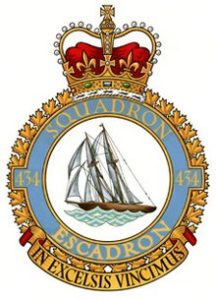 No. 434 Squadron
No. 434 Squadron
Badge A representation of the schooner “Bluenose”
Motto In excelsis vincimus (We conquer in the heights)
Authority King George VI, October 1945.
The squadron was adopted by the Rotary Club of Halifax, Nova Scotia and took the nickname “Bluenose” in reference to the common nickname for Nova Scotians. The schooner ‘Bluenose’ is well known for its fine record.
Formed at Tholthorpe, Yorkshire, England on 13 June 1943 as the RCAF’s 31st – 13th Bomber – squadron formed overseas, the unit flew Halifax and Canadian-built Lancaster aircraft on strategic and tactical bombing operations. After hostilities in Europe, it was selected as part of “Tiger Force” for duty in the Pacific, and returned to Canada for reorganization and training. The sudden end of the war in the Far East resulted in the squadron being disbanded at Dartmouth, Nova Scotia on 5 September 1945.
Brief Chronology: Formed at Tholthorpe, Yorks., Eng. 13 f Jun 43. Disbanded at Dartmouth, N.S. 5 Sep 45.
Title or Nickname: “Bluenose”
Adoption: Rotary Club of Halifax, N.S.
Commanders
- W/C C.E. Harris (Can/RAF), DFC 15 Jun 43 – 6 Feb 44.
- W/C C.S. Bartlett, DFC 7 Feb 44 – 12 Jun 44 KIA.
- W/C F.H. Watkins, DFC 13 Jun 44 – 29 Aug 44.
- W/C A.P. Blackburn, DFC 30 Aug 44 – 7 Apr 45.
- W/C J.C Mulvihill, AFC 8 Apr 45 – 5 Sep 45.
Higher Formations and Squadron Locations
Bomber Command:
No. 6 (RCAF) Group,
- Tholthorpe, Yorks. 13 Jun 43 – 10 Dec 43.
No. 64 (RCAF) Base,
- Croft, Yorks. 11 Dec 43 – 9 Jun 45.
- En route to Canada 10 Jun 45 – 14 Jun 45.
RAF ‘Tiger Force” (for ops), RCAF Eastern Air Command (for training):
No. 6 (RCAF) Group,
No. 662 (RCAF) Wing,
- Dartmouth, N.S. 15 Jun 45 – 5 Sep 45.
Representative Aircraft (Unit Code WL)
Handley Page Halifax B.Mk.V (Jun 43 – May 44)
- EB217 A EB258 T DK251 F DK262 R LL666 T LK669 Z LK708 L LK709 E LK801 D LK907 M LK945 0 LK972 N LL136 E LL137 D LL243 U LL288 P
Handley Page Halifax B.Mk.III (May – Dec 44)
- LW171 M LW433 W LW713 P LW714 H MZ405 F MZ420 F MZ421 A MZ626 T MZ276 Y MZ878 E MZ920 C MZ921 Q NA552 U NP939 W NR121 G NR144 V
Avro Lancaster B.Mk.X (Dec 44 – Sep 45)
- KB789 V KB814 S KB816 G KB824 E KB825 A KB826 K KB830 D KB832 F KB833 B KB834 Y KB835 J KB836 H KB840 N KB842 L KB843 Q KB844 W KB846 P KB849 T KB850 0 KB852 R KB863 P KB973 G KB880 L KB885 Q
During Feb-Mar 45 six B.Mk.l & III’s were flown by the squadron: NG343 U NG344 Z NG345 Q NG497 P PA225 0 PA226 X
Operational History: First Mission 2 August 1943, 4 Halifax V’s from Tholthorpe – sea search.
First Mission: Bombing 12/13 August 1943, 10 Halifax V’s from Tholthorpe dispatched to bomb Milan, Italy; 9 bombed the primary target, 1 aborted.
Last Mission: 25 April 1945, 15 Lancaster X’s from Croft bombed gun positions on the Island of Wangerooge.
Summary Missions/Sorties: 198/2582 (missions included 179 bombing, 17 minelaying, 1 diversionary, 1 sea search; sorties include 45 on POW airlift).
- Operational/Non-operational Flying Hours: 14,622/6579.
- Bombs dropped: 10,358 tons (plus 225 mines).
- Victories: Aircraft: 7 destroyed, 2 probably destroyed, 4 damaged.
- Casualties:
- Operational: 75 aircraft; 484 aircrew, of whom 34 were killed, 313 presumed dead, 121 POW (of whom 2 died, 2 escaped), 16 evaded capture or proved safe.
- Non-operational: 9 personnel, of whom 8 killed, 1 died of natural causes.
Honours and Awards: 6 bars to DFC, 108 DFC’s, 6 DFM’s, 1 BEM, 7 MiD’s.
Battle Honours:
- English Channel and North Sea 1943-1944.
- Baltic 1943-1944.
- Fortress Europe 1943-1944.
- France and Germany 1944-1945: Biscay Ports 1944, Ruhr 1943-1945, Berlin 1943-1944, German Ports 1944-1945, Normandy 1944, Rhine.








